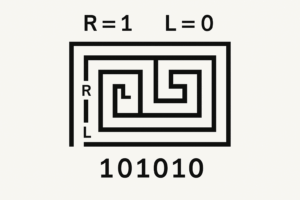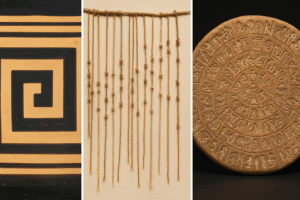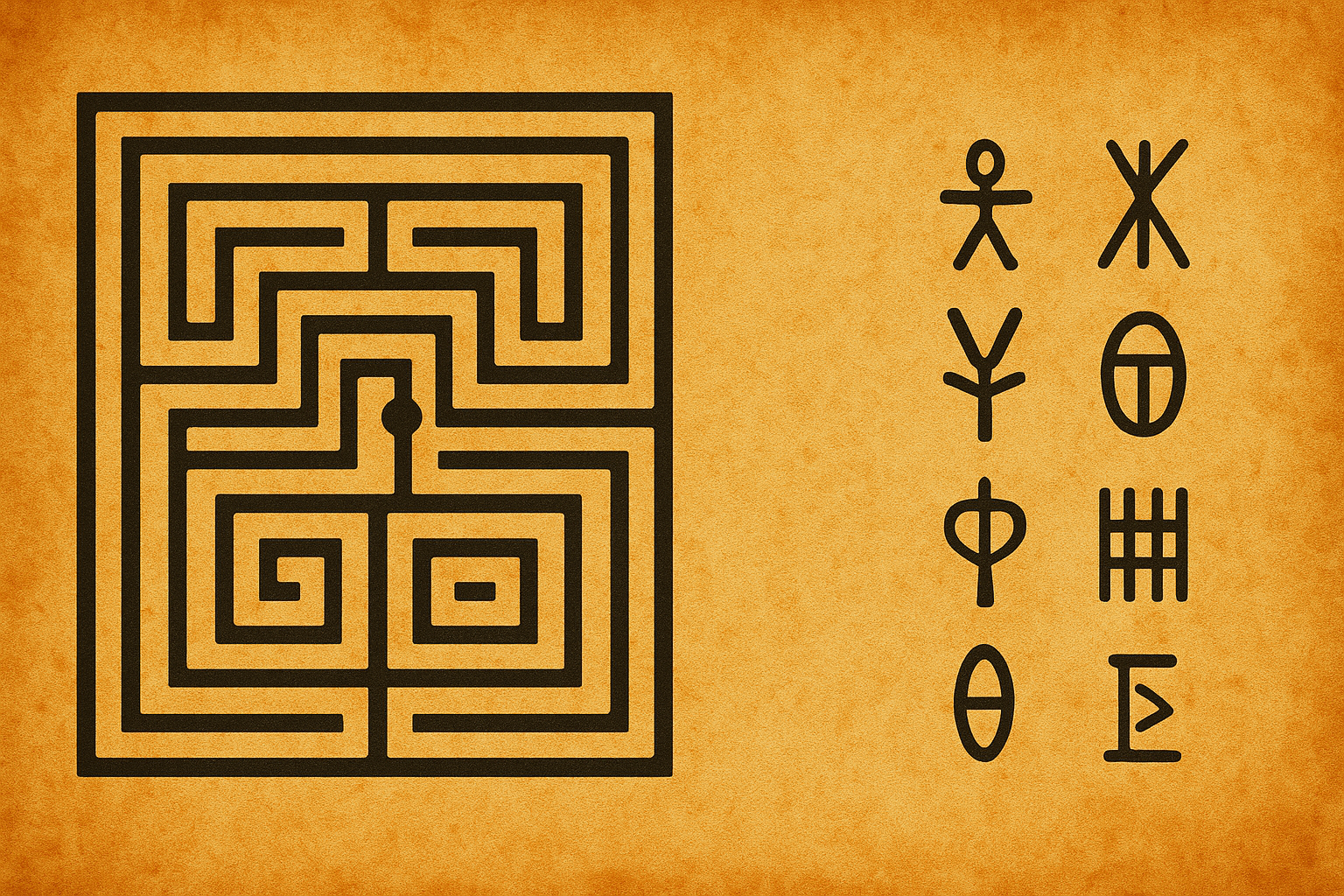We often think of ancient patterns as decorative, but what if they were something more—something encrypted? The meander, a recurring motif in Greek and Roman art, is usually dismissed as geometric ornamentation. But a new interdisciplinary hypothesis suggests these labyrinthine designs may encode information. Could Meander Codes represent a forgotten form of proto-encryption rooted in pattern recognition, spatial logic, and cultural symbolism?
What Is a Meander Pattern?
 Before diving into the cryptography, let’s get the basics straight. A meander is a continuous linear motif—resembling a winding path—that forms right-angled turns and loops. Often referred to as the Greek key or fret, it appears in ancient architecture, mosaics, pottery, and textiles.
Before diving into the cryptography, let’s get the basics straight. A meander is a continuous linear motif—resembling a winding path—that forms right-angled turns and loops. Often referred to as the Greek key or fret, it appears in ancient architecture, mosaics, pottery, and textiles.
You’ve seen it before: repeated around borders, across columns, along floors of Roman villas. Its mathematical elegance lies in the fact that the path never intersects itself, creating an unbroken visual rhythm.
Traditionally, meanders are considered decorative or symbolic. In some interpretations, they represent eternity, unity, or the river Meander from Anatolia. But none of these fully explains their obsessive use, nor the variation in forms. Could there be more beneath the surface?
Introducing the Hypothesis: Meander as Code
The Meander Code Hypothesis proposes that these labyrinthine motifs might have functioned as symbolic or encrypted messages, readable only to initiates or specific social groups.
This idea stems from several observations:
- Structural Regularity: Many meanders contain repeating modules, branch points, and corner shifts suggestive of binary or modular logic.
- Variability: While the core pattern remains, variations in tile arrangement hint at non-random selection—like different “keys” in a cipher.
- Historical Context: The Greeks, Etruscans, and later Romans were no strangers to codes—acrostics, steganography, and early cryptographic tools were known.
The hypothesis doesn’t claim that every meander is a message. Rather, it suggests that some may encode status, knowledge, names, or instructions in a visual language—functioning as a form of spatial mnemonics or geometric encoding.
The Anatomy of a Meander
Understanding how a meander could work as a code requires examining its structure. Most meanders consist of:
- Entry Point: Where the line begins.
- Turn Sequences: The arrangement of right and left turns.
- Modules: Repeating blocks or cells (typically rectangular or square).
- Exit Point: Where the line concludes or loops.
Let’s treat the path as a graph: each turn becomes a node, and each straight segment an edge. Suddenly, the meander is no longer a pattern—it’s a walkable labyrinth with encoded choices.
Here’s where the cryptographic twist begins: directional sequences, corner frequencies, and segment lengths can all become symbolic. For instance, assigning a 1 to every right turn and a 0 to every left one turns the path into a binary stream.
Meanders and Proto-Encryption
Encryption, at its core, is about hiding meaning in structure. Modern ciphers use mathematical algorithms. Ancient ones? They used art, geometry, and myth.
Let’s consider a few possibilities:
1. Binary Encoding
 By converting path directions (left/right) into binary digits, one could encode numeric values, names, or dates. Example:
By converting path directions (left/right) into binary digits, one could encode numeric values, names, or dates. Example:
- RLRLRR → 101101 → Decimal 45
- LLLRRR → 000111 → Decimal 7
This simple encoding could be applied to the meander’s path or even to the sequence of modules in a border.
2. Spatial Mnemonics
Each turn could represent a memory cue. Meanders might have helped initiates remember sacred texts, laws, or rituals—similar to how memory palaces use physical space for cognitive storage.
3. Topological Keying
Some meanders require tracing through multiple dimensions—folded or mirrored paths. These could act as combinatorial locks, where the correct route unlocks the pattern’s message.
This idea aligns with labyrinths used in ritual practice—not just for walking, but as metaphors for journeys of the mind.
Cultural Clues: Where Form Meets Function
Evidence for intentional variation appears across Mediterranean cultures. For example:
- Greek pottery: Some amphorae feature meanders with deliberate asymmetries—just one module different among many.
- Roman mosaics: Meanders framing inscriptions often contain distortions near the text, suggesting structural linkage.
- Etruscan tombs: Architectural meanders occur near doorways and altar sites, sometimes connected with symbolic animals or glyphs.
Even more curiously, some Minoan tablets contain repetitive linear patterns that resemble meanders—though they’re still undeciphered.
Visual Encryption in Other Cultures
 While the Meander Code is not a proven system, there’s precedent for visual-symbolic encryption in antiquity:
While the Meander Code is not a proven system, there’s precedent for visual-symbolic encryption in antiquity:
- The Phaistos Disc (Crete, ca. 2nd millennium BCE): A spiral of pictographic stamps, possibly a symbolic script or game.
- Quipu (Inca): Knotted strings used to store information—numbers, records, and perhaps even stories.
- Islamic geometric patterns: Sometimes designed with recursive symmetry rules encoding numerological or spiritual concepts.
The point is: visual patterning as a medium of meaning is not new. Meanders could simply be Europe’s overlooked entry in this tradition.
Counterarguments and Caveats
Not everyone is convinced—and rightly so. Critics of the Meander Code Hypothesis point out:
- No explicit records link meanders to coding.
- Interpretations risk pareidolia—seeing patterns where none were intended.
- The idea depends on subjective decoding rules.
In response, proponents argue that lack of textual proof doesn’t invalidate the possibility. Many ritual or secret systems—by design—leave few records. Just because we don’t know the rules doesn’t mean there were none. Absence of evidence is not evidence of absence—especially in cultural archaeology, where decoding intent requires both rigor and imagination.
Additionally, the patterned variations and modular anomalies across regions suggest more than random design decisions. These deviations might represent intentional signals—visible to those “in the know,” but invisible to outsiders. In ancient hierarchical societies, information control was often embedded in ritual, architecture, and symbols. A code hidden in plain sight would serve both as decoration and discretion.
From Meander to Machine: Could This Inspire Modern Ciphers?
If the Meander Code Hypothesis holds any weight, it may influence more than archaeology—it could provide inspiration for novel encryption models. Unlike traditional ciphers based on text or numbers, meander-based systems would be spatial, visual, and geometric.
Here are some hypothetical applications:
1. Graph-Based Cryptography
Model a meander as a non-intersecting planar graph. Each corner, branch, and loop represents an operation or transformation. The result: a cipher that’s non-linear and hard to brute-force with conventional tools.
2. Tactile Encryption
Imagine wearable encryption—bracelets, textile patterns, or etched objects—where access to the message requires tracing a specific path with a key. This tactile approach could be useful for covert communication, even in modern contexts.
3. Mnemonic Ciphers
Combine spatial logic with symbolic markers to create non-digital security systems. For instance, a printed poster with a hidden meander-like sequence could store information retrievable only by following a specific visual rule.
These approaches align with emerging interest in post-quantum cryptography, where purely mathematical keys might one day be obsolete. Visual-spatial encryption may offer a layer of security no AI can easily guess.
Why It Matters: Culture, Code, and the Limits of Perception
The Meander Code Hypothesis is not just about ancient art—it challenges our assumptions about how knowledge was stored and transmitted. If true, it reframes the meander from aesthetic flourish to cognitive tool.
It invites reflection on:
- How societies conceal vs. reveal knowledge
- The role of geometry in cultural memory
- Our tendency to overlook non-textual systems of information
It also resonates with current research in cognitive archaeology, where patterns in tools, dwellings, and artwork are studied as reflections of thought systems—not just utilitarian or decorative objects.
Experimental Approaches: How Could We Test It?
Though it’s speculative, the Meander Code Hypothesis can be explored with modern tools:
- Pattern Analysis: Use computer vision to scan thousands of ancient meanders and look for modular anomalies or recurring variations.
- Graph Theory Modeling: Convert meander paths into graph structures to analyze for mathematical patterns, frequencies, and potential encodings.
- Crowdsourced Decoding: Like with the Voynich Manuscript, open the problem to mathematicians, cryptographers, and pattern theorists. Could cross-disciplinary perspectives yield common rules?
- Machine Learning Simulations: Train AI to recognize deliberate variation vs. random design. Could it learn to distinguish “pattern as code” from “pattern as art”?
Each of these would provide testable insights—bringing the hypothesis from the realm of speculation into empirical archaeology.
TL;DR
- Meanders are repeating labyrinth-like patterns found in ancient art, often seen as decorative.
- The Meander Code Hypothesis proposes that some of these motifs may encode information using spatial logic.
- Encoding could take the form of binary direction, mnemonic cues, or graph-based message structures.
- Similar forms of visual encryption appear in other cultures, such as quipu, Islamic tiling, or the Phaistos Disc.
- While speculative, the theory is testable using modern tools like AI pattern analysis, graph theory, and visual decoding.
References
- Leroi-Gourhan, A. (1993). Gesture and Speech. MIT Press.
- Livio, M. (2002). The Golden Ratio: The Story of Phi, the World’s Most Astonishing Number. Broadway Books.
- Robinson, A. (2007). The Story of Writing: Alphabets, Hieroglyphs and Pictograms. Thames & Hudson.
- Fort, E., Couder, Y. (2010). “Hydrodynamic analogs of quantum behavior.” Nature Physics, 6, 735–743.
- Jensen, H. J. (2018). “Labyrinths, Memory, and Pattern Recognition in Ancient Visual Culture.” Journal of Archaeological Method and Theory, 25(2), 490–509.
- Turing, A. M. (1936). “On Computable Numbers.” Proceedings of the London Mathematical Society.
- Davis, M. (2000). Engines of Logic: Mathematicians and the Origin of the Computer. W.W. Norton & Company.
Discussion
If ancient cultures embedded meaning in patterns we’ve long dismissed as art—what other messages might be hiding in plain sight?
